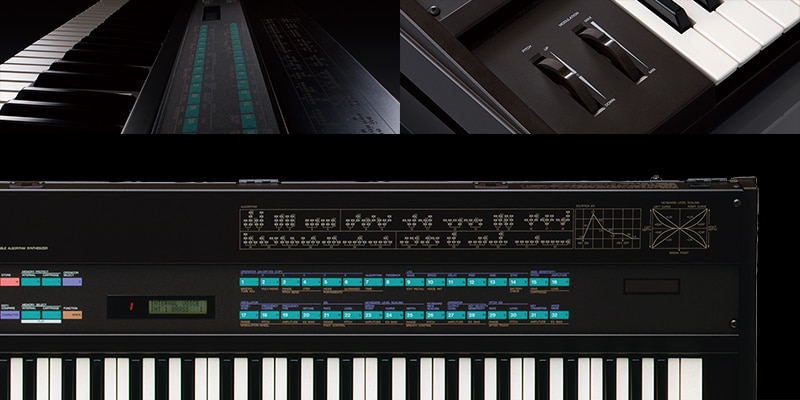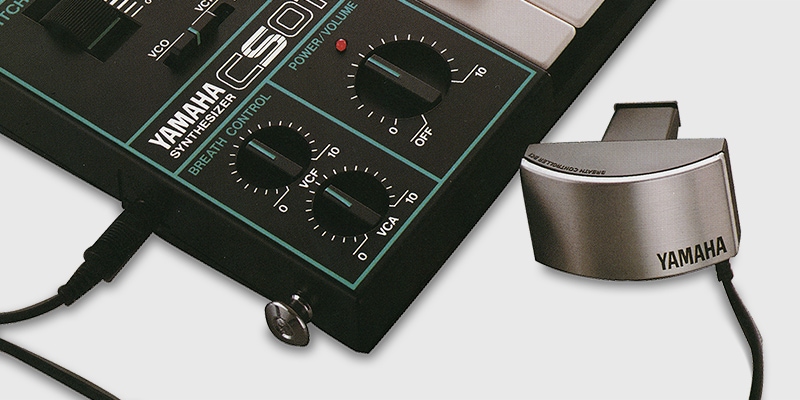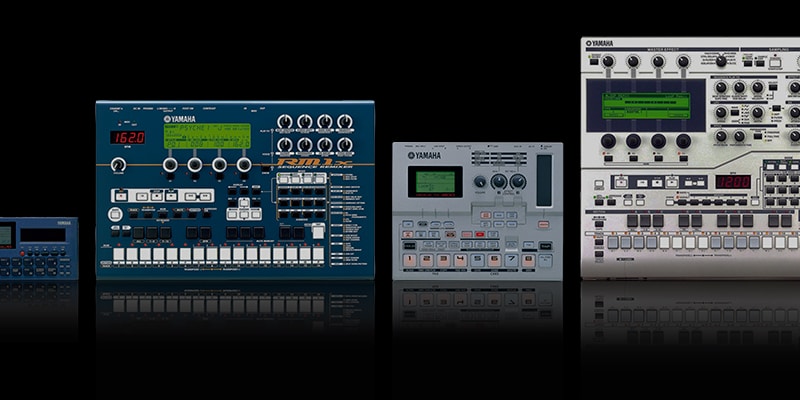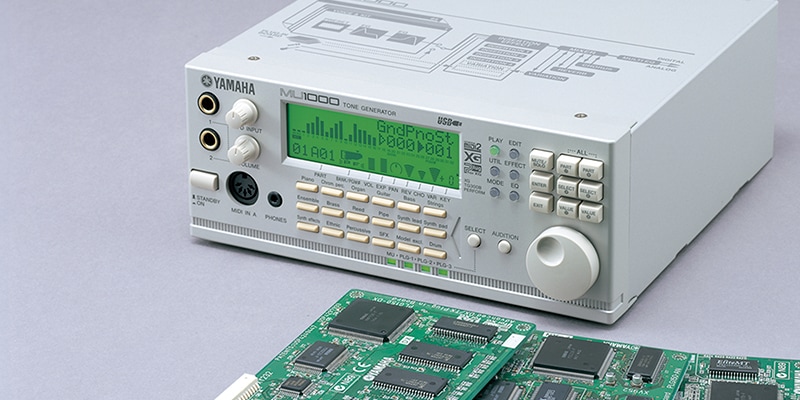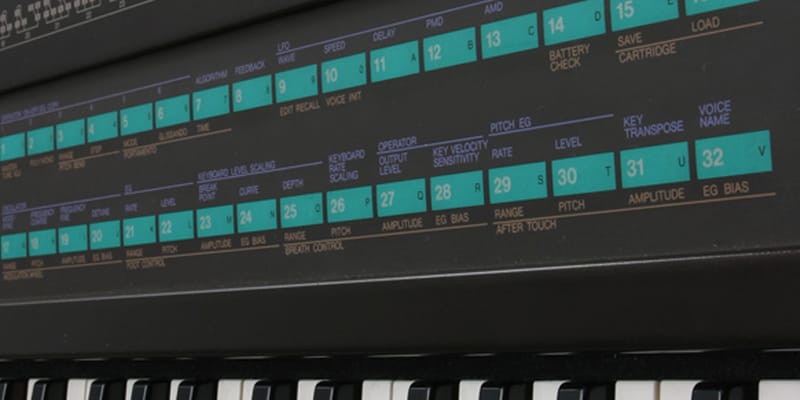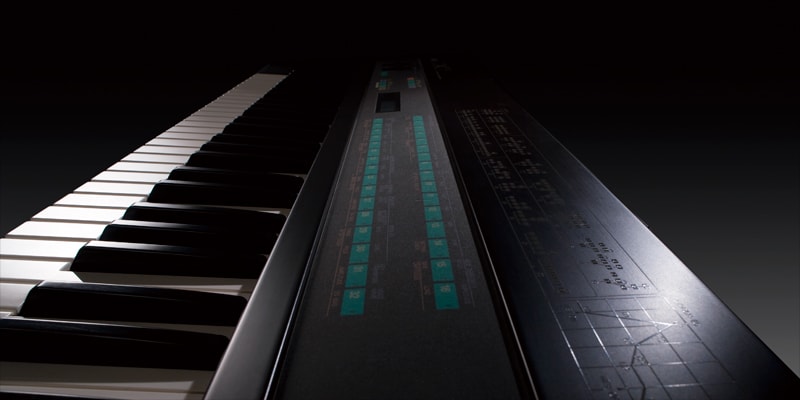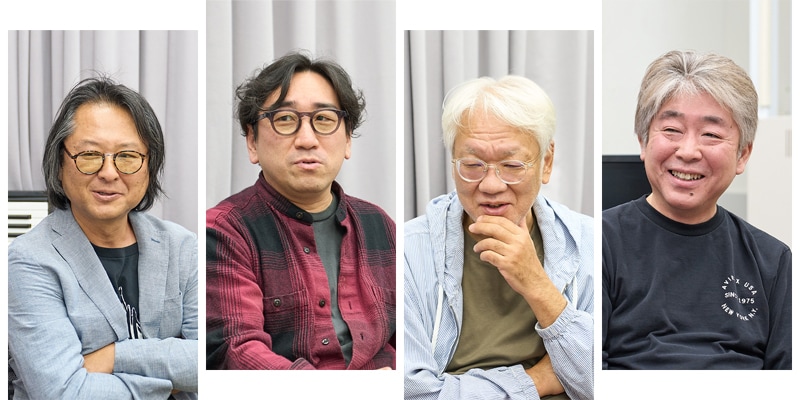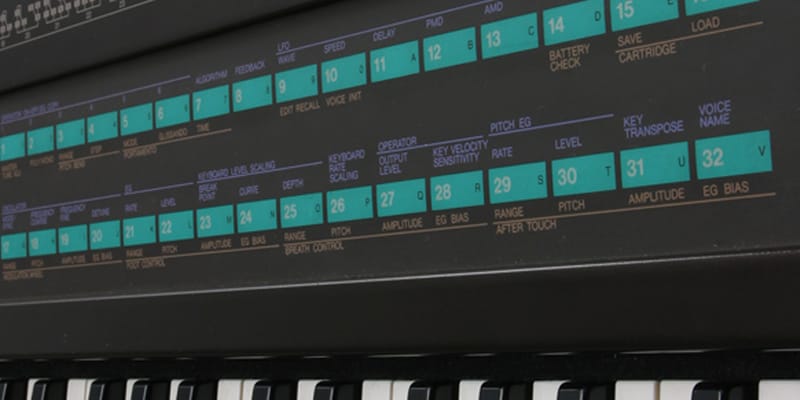How FM Tone Generation Works
![[Figure 1]Using a low-frequency oscillator to change frequencies](/nl/files/anecdote_04-1_fig1_en_f34f3fc032e2b43caa419345d792731e.jpg?impolicy=resize&imwid=640&imhei=320)
The FM in "FM tone generation" is an abbreviation for "frequency modulation." The wheel-shaped controller at the left of the synthesizer is called a "modulation wheel," and utilizes the same kind of modulation. This wheel modulates the sound of the instrument with frequencies from a low-frequency wave generator called an LFO (low frequency oscillator), causing the frequency of the original sound to increase and decrease slightly (raising and lowering the pitch) repeatedly as shown in the diagram, producing a vibrato effect.
So, what happens when the LFO frequency is increased?
Using waveforms with a frequency close to or higher than that of the original sound to raise or lower the pitch causes the pitch to rise and fall within the fundamental period that we perceive as pitch, distorting the waveform. A similar principal is used in FM tone generation to distort waveforms, making it possible to create a wide variety of sounds.
In reality, the progress of phases that change linearly over time is altered for output as sound; a complex process that we will explain here using images.
Imagine the rotating wheel of a car.
If the car is traveling at a constant speed, the rotation time of the wheel is also constant.
Placing a mark at the left edge of the wheel and then graphing a track of its vertical movement will result in a waveform similar to a perfect sine wave.
Let's assume that in order for the car speed to remain constant, the time required for the wheel to make one complete rotation is also constant. What happens if this rotational speed is uneven?
As an example, let's suppose that the wheel rotates comparatively quickly until the mark reaches the twelve o'clock position, decelerates continuously until it reaches the six o'clock position, and then accelerates rapidly during the last quarter of rotation to make up for lost time.
The graph for this movement will be a waveform that differs from a sine wave, as shown in fig. 2-b.
While this would make for an uncomfortable car ride, there would be no difference in the forward speed of this car and the speed of a car in which there was no variation in the rotational speed of the wheels. This is the same for sound, where the pitch remains the same.
The waveform that creates these alterations—the variations in rotation—is thus a "modulating waveform," and in this example we can presume that it is a sine wave with the same frequency as the rotational frequency of the car wheel.
![[Figure 2]2-c](/nl/files/anecdote_04-4_fig2-c_en_64d34583f8bd447b6635fa8953d5381c.jpg?impolicy=resize&imwid=640&imhei=320)
Increasing the effect of the variations in rotation causes the track of the mark to increase in complexity, and in some cases reverse rotation may even occur in order to maintain a uniform rotational period.
The result is a track like that shown in fig. 2-c.
The original track caused by the wheel rotation is thus the waveform that is modulated, while the controlling waveform that creates the variations in rotation (with positive changes caused by the accelerator, and negative changes by the reverse gear rather than the brake) can be regarded as the modulating waveform.
![[Figure 3]An example of modulation with a frequency 10 times that of the original sound](/nl/files/anecdote_04-5_fig3_en_2d9dc1535ef75f3fc7cc23b46d96cf2f.jpg?impolicy=resize&imwid=640&imhei=320)
To return to sound, the fundamental concept of FM tone generation is to modulate a waveform with other different waveforms to create a variety of new waveforms. Different modulation waveform frequencies and levels of modulation can be used to create complex changes.
For example, let's examine what happens when a waveform with ten times the frequency of the original waveform is used for modulation.
As this diagram shows, using modulation in this manner produces small undulating elements within the large sine wave. Extremely high-frequency harmonic elements are being produced at much higher frequency levels than the original frequency, creating a metallic sound element.
![[Figure 4]The example from fi g. 3 with temporal changes added](/nl/files/anecdote_04-6_fig4_en_7086175c6e5a27e161894d39fd21ea76.jpg?impolicy=resize&imwid=640&imhei=320)
Using an EG (envelope generator) to change the volume of the modulating waveform (the level of modulation) over time makes the attack of the sound metallic, while the decay and release sections gradually become gentler, allowing changes to be made to the sound over time.
![[Figure 5]How sound is made in an FM tone generator](/nl/files/anecdote_04-7_fig5_en_172f1e9c28ab1799186de54c1ade5ce6.jpg?impolicy=resize&imwid=640&imhei=480)
In FM sound generation, the operator (the device that generates sine waves, etc.) for the modulated waveform is called the "carrier," and that of the modulating waveform, a "modulator." This groundbreaking sound generation system adjusts the carrier/modulator combination and alters their respective levels and envelopes, and is capable of producing waveforms that are vastly different from the original waveform of the operator.



![[Figure 2]2-a](/nl/files/anecdote_04-2_fig2-a_en_7221e117bb20f4a4deb69284830f69fa.jpg?impolicy=resize&imwid=800&imhei=400)
![[Figure 2]2-b](/nl/files/anecdote_04-3_fig2-b_en_58ffe1c2542437795237ab67e2c156a6.jpg?impolicy=resize&imwid=800&imhei=400)



